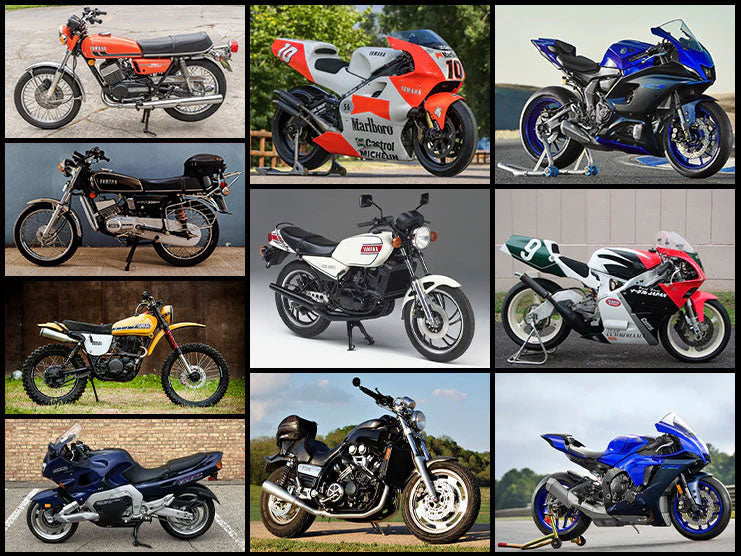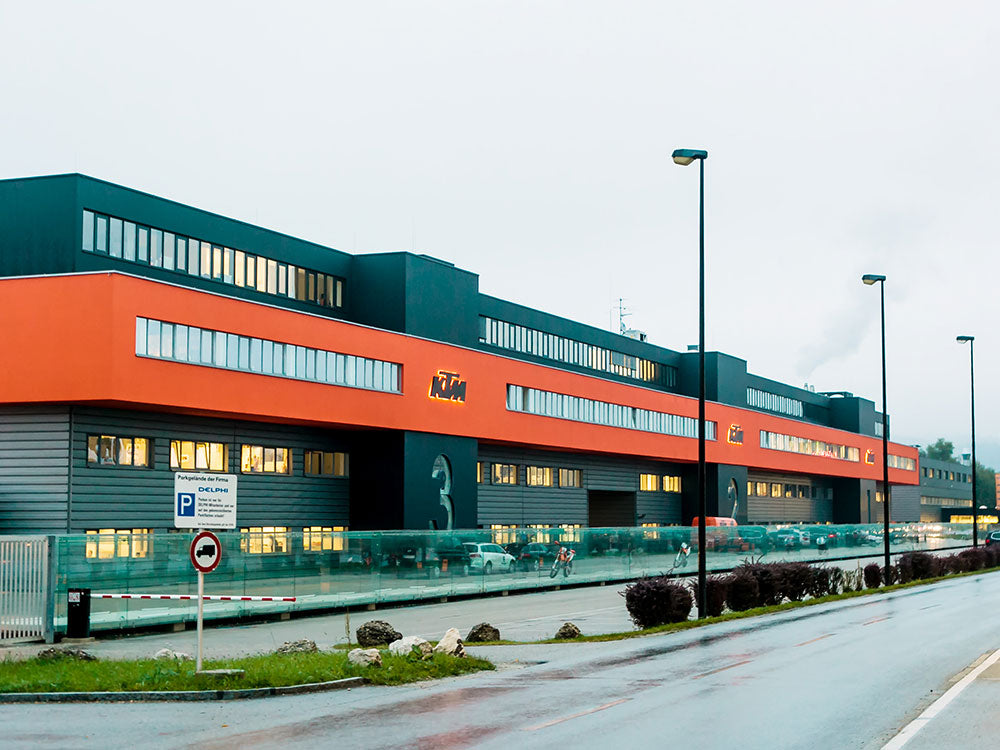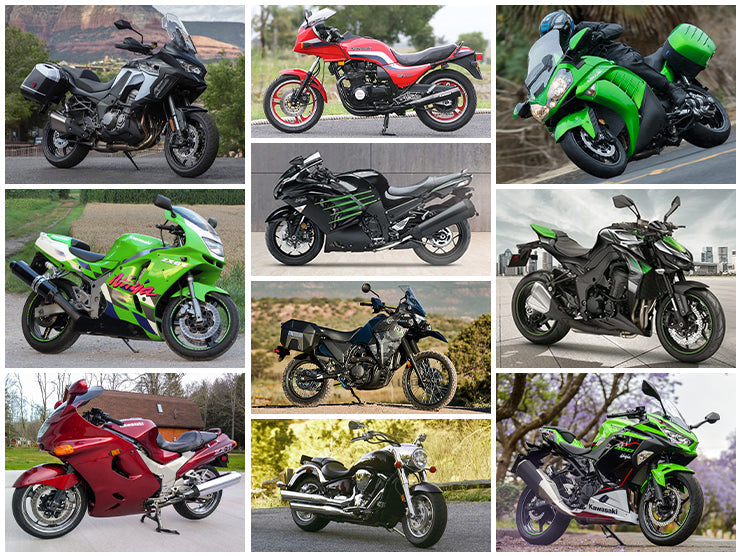Yamaha’s motorcycle production camp was founded in 1955, after World War II, and has become the second-largest motorcycle manufacturer in the world after establishing itself as the largest manufacturer of musical instruments. Over the years, Yamaha has produced some of the finest motorcycles that outshined other bikes in looks, performance, reliability, fun factor, and comfort. Resultantly, the brand’s innovative motorcycles earned it much success in both on-road and off-road segments. In this article, Viking Bags has compiled a list of the best motorcycles Yamaha ever made.
Table of Content
1. The Story of Yamaha Motorcycles
From music to motorcycles, Yamaha has had an epic journey. Though Yamaha was the last Japanese company to make motorcycles, it was the first company that emphasized motorcycles’ looks, demonstrating to the world what a motorcycle should look like. According to Yamaha’s motorcycle design concept, a motorcycle should be simple, powerful, and compact. The company also applied Kondo to its motorcycles. Kondo is an old Japanese philosophy that describes the impact of music and the beauty of anything on human emotions. The company believes that it rose to the height of success by connecting the ancient Japanese concept of Kondo to motorcycles and by making music with their bikes. Yamaha’s logo, which is a three-pointed tuning fork, is a symbol of a connection between music and motorcycles.
But right after World War II, people were only focused on survival and needed cheap transportation, in addition to food and shelter. To stay in business, Yamaha decided to make motorcycles. Yamaha applied the special metal technologies it used to make pianos for the production of motorcycles. In August 1954, Yamaha introduced its first motorcycle, the YA-1, in 1954.
1.1 Yamaha YA-1 - Yamaha’s Success Marker!
The YA-1 was a small 125 cc single-cylinder motorcycle. The engine was a clone of a German motorcycle, DKW RT 125. Due to its color and design, the YA-1 has immediately nicknamed Aka-tombo or the Red Dragonfly. At the time of YA-1’s launch, other motorcycles in Japan were usually painted black with little focus on chassis structure and other aesthetic details. The Yamaha YA-1’s aerodynamic fuel tank shape and compact chassis confirmed that Yamaha was serious about manufacturing aesthetically appealing motorcycles that could also perform. Only a few weeks after the production of the YA-1, Yamaha entered the motorcycle in two racing competitions held in Japan: the Mount Fuji Hill Climb and the Asama Volcano Race. This was Yamaha’s way to catch up with other motorcycle companies.
The YA-1 or the red dragonfly won the Mount Fuji Hill Climb race and then the first running of the Asama Volcano Race. By winning these races, Yamaha demonstrated that its bikes were not only beautiful but also had power and performance. The promotional strategy worked and YA-1 attracted many buyers. By the end of 1955, Yamaha was producing 200 motorcycles each month. The YA-1 was discontinued in 1958.
1.2 Yamaha YD-1 - The First Official Racing Bike
One year into the motorcycle business, Yamaha introduced the YD-1 in 1957. The motorcycle featured a two-cylinder air-cooled 250 cc engine, twice as big as the YA-1. Unlike the 125 cc engine of the YA-1, this engine was engineered by Yamaha engineers; hence, it was a Yamaha original. With a top speed of 70 mph and a horsepower of 15 hp, the YD-1 redefined the miles a motorcyclist could cover on a two-wheeler. In addition, the bike set the tone for Yamaha’s design concept. None of the engine components featured a cover as the design team wanted potential buyers to see the Yamaha parts. Whether this was Yamaha’s strategy to develop trust with its audience is unknown; however, the idea was in sync with the company’s design philosophy as it allowed riders to be influenced by the power and beauty of the machine. The YD-1 featured a two-tone orange and white paint that made the motorcycle even more eye-catching. The production of YD-1 was discontinued in 1958 but not before Yamaha started bigger endeavors.
1.3 Stepping into the Overseas Market
After three years into the business, Yamaha was all set to establish itself overseas. By the end of 1958, the company began selling motorcycles, including in the United States. The YD-1 was the first Yamaha motorcycle ever sold in the United States. This step cemented Yamaha and the success of its racing two-stroke bikes in the overseas motorcycle market.
1.4 Entering the Dual-Sport Segment
In the late 1960s, Yamaha produced DT-1, the first bike ever designed as a motorcycle that you could ride on the road and take down on dirt trails. The precision, sharp performance, and handling of these bikes were impressive and the timing of their launch just perfect. The economic situation was stable, people had the money and time to spend on adventure. The first DT-1 was launched in 1968 in America and quickly became popular. The simple design, power, off–road and on-road capabilities, attracted riders. DT-1 proved that the concept of Kondo can be applied to machines as Yamaha catered to the human need for adventure with a beautiful dual sport bike that evoked feelings of thrill and excitement.
1.5 Becoming the Second Largest Motorcycle Manufacturer
From copying a German motorcycle engine in 1954 to launching a unique motorcycle with off-road capabilities, Yamaha internationally established itself as a reliable motorcycle brand within 10-15 years. Each of Yamaha’s machines and designs were unique catering to the preference and needs of a range of riders.
After all these achievements, Yamaha invested all its time and efforts to engineer a revolutionary four-stroke engine. In 1970, Yamaha engineers designed and built the XS-1 motorcycle featuring a four-stroke engine. Up until this point, all Yamaha motorcycles were powered by a two-stroke engine.
The XS-1 was sold under the label XS-650 in the United States. Though the two-cylinder XS-650 engine was inspired by British motorcycle engines, the Yamaha engine produced more power. The XS-650 generated 53-hp horsepower at 7,000 rpm. The XS-650 engine was durable, and fast, and became the basis of other Yamaha motorcycles.
2. Yamaha’s 10 Best Bikes of All Time
After the XS-650, Yamaha came with new cutting-edge designs in each decade if not each year to retain its place in the motorcycle industry. Listed below are the ten best motorcycles Yamaha ever made.
2.1 Yamaha YZF R1

Yamaha produced its first sports bike in 1985 which evolved into the Yamaha R1 series. The 1000 ccc YZF-R1 is one of Yamaha’s best performing sports bikes to date. With the YZF-R1, Yamaha gave tough competition to Honda’s FireBlade and created its own fanbase. For some riders, YZF-R1 is better than FireBlade because it feels lighter and more agile than the FireBlade and generates the same amount of power. YZF-R1 continues to be a top notch sports bike even after twenty five years and deserves the first place in this list.
| Yamaha YZF-R1 Quick Facts | |
|---|---|
| Category | Sport Bike |
| Production Years | 1998-present |
| Displacement | 998 cc |
| Horsepower | 199 hp |
| Maximum Speed | 182 mph |
| Transmission System | Six Speed |
| Weight | 448 lbs |
2.2 Yamaha TZ 250 - Race Bike

Yamaha launched a commercial race bike TZ250 in 1973 which was powered by a two-stroke 250 cc engine. The bike was a huge success, so in 1990 Yamaha further improved the bike by installing a 90-degree liquid cooled V–Twin engine with a crankcase reed intake. Other notable specifications of the bike included a smooth six-speed transmission and 91 hp horsepower. The Yamaha TZ250 won many All Japan Road Race Championships throughout its production years. Yamaha discontinued the bike after the World Championships motorcycle regulations changed.
| Yamaha TZ 250 Quick Facts | |
|---|---|
| Category | Race Bike |
| Production Years | 1973-2008 |
| Displacement | 247 cc |
| Transmission System | Six Speed |
| Horsepower | 76 hp |
| Maximum Speed | 140 mph |
| Weight | 242 lbs |
2.3 Yamaha GTS 1000

Yamaha GTS 1000 is known as the coolest 90s sports bike. The motorcycle featured a 1002 cc engine but gained more popularity due to its alternative front suspension concept. The GTS 1000 engine was a modified version of FZR1000’s DOHC inline engine. The catalytic converter for the exhaust system was another important feature that this bike introduced to the industry. Standard anti-lock braking systems for American models and a fuel injection system also got a lot of hype, making GTS 1000 an iconic Yamaha bike. Other than its powerful engine, fuel system, and advanced braking setup, the bike’s customizability made it popular among motorcycle touring enthusiasts. Affordable Yamaha aftermarket luggage bags, fairings, and other travel-friendly accessories greatly contributed to the bike’s touring capabilities and its success.
| Yamaha GTS 1000 Quick Facts | |
|---|---|
| Category | Sport Touring |
| Production Years | 1993-1999 |
| Displacement | 1002 cc |
| Horsepower | 102 hp |
| Maximum Speed | 140 mph |
| Transmission System | Five Speed |
| Weight | 542 lbs |
2.4 Yamaha RD 350

In 1973, Yamaha introduced the RD350 motorcycle continuing its two-stroke engine technology. The RD350 engine boasted an innovative power valve system that improved engine performance and outputs. The RD 350 generated an impressive 59 hp of horsepower and delivered strong acceleration. The disc brake was also a special feature of the RD 350 as motorcycles of that era were not usually equipped with one.
| Yamaha RD 350 Quick Facts | |
|---|---|
| Category | Sport Bike |
| Production Years | 1973-1975 |
| Displacement | 347 cc |
| Horsepower | 59 hp |
| Maximum Speed | 105 mph |
| Transmission System | Six Speed |
| Weight | 315 lbs |
2.5 Yamaha RZ 250

In 1980, Yamaha introduced the RD250 at the Tokyo Motorcycle Show at the Tokyo International Exhibition Center, a place where all Japanese companies introduce their new motorcycles to the public. Due to its narrow compact design, the motorcycle offered a tight knee grip, allowing the rider to fit properly on the motorcycle. The lightweight chassis together with a two stroke engine made the RZ250 an enjoyable two-wheeler. The motorcycle’s sleek design and 250 cc displacement also hinted at Yamaha’s racing expertise. Due to its historical importance, the Yamaha RZ250 has become one of the most sought after collector bikes.
| Yamaha YZ 250 Quick Facts | |
|---|---|
| Category | Sport Bike |
| Production Years | 1980-1981 |
| Displacement | 250 cc |
| Horsepower | 45-50 hp |
| Maximum Speed | 98 mph |
| Transmission System | Six Speed |
| Weight | 352 lbs |
2.6 Yamaha XT500

Launched in 1976, Yamaha XT500 is now considered a vintage enduro bike. The motorcycle was discontinued in 1989 but is still one of the most powerful enduros available on the market. In addition to exceptional off-road capabilities, the XT500 also comes with street-legal features. The bike is on the heavier side with a small suspension travel, but its low-end torque makes it a fun ride.
Yamaha XT500 is also regarded as the pioneer of the motorcycle dual-sport segment, and after winning several off-road competitions, the bike became a symbol of adventure.
| Yamaha XT500 Quick Facts | |
|---|---|
| Category | Enduro |
| Production Years | 1976-1989 |
| Displacement | 499 cc |
| Horsepower | 33 hp |
| Maximum Speed | 87 mph |
| Transmission System | Five Speed |
| Weight | 306 lbs |
2.7 Yamaha YZF-R7

Yamaha YZF-R7 was an innovative modern sport bike inspired by the YZF750R, a racing bike. This midsize sports bike has a twin cylinder engine that generates impressive yet manageable horsepower of 106 hp. The bike was also well-equipped with rider aid modes, connectivity options, and different riding modes that improve the riding experience. Motorcyclists can ride this bike on streets and on race tracks based on their preferences. Through the YZF-R7, Yamaha reached out to the audience who admired YZF-R1 but did not ride it because of its really high power outputs, 199 hp of horsepower.
| Yamaha YZF-R7 Quick Facts | |
|---|---|
| Category | Sport Bike |
| Production Years | 1999-2002 |
| Displacement | 749 cc |
| Horsepower | 106 hp |
| Maximum Speed | 163 mph |
| Transmission System | Six-Speed |
| Weight | 416 lbs |
2.8 Yamaha RX 100

In 1985, Yamaha launched the RX100 featuring a small 98 cc engine that only generated a mellow horsepower of 11 hp. Yamaha designed the RX100 for riders who wanted to ride motorcycles but were either intimidated by the powerful engines or huge price tags. The RX 100 was an affordable bike with great reliability, excellent stability, and comfort. This lightweight bike created a new niche by addressing the gap in the motorcycle market. Though the bike was not officially launched in the United States due to emission standards and different market trends, it played an important role in establishing Yamaha as the second-largest motorcycle producer in the world.
| Yamaha RX 100 Quick Facts | |
|---|---|
| Category | Classic Motorcycle |
| Production Years | 1985-1996 |
| Displacement | 98 cc |
| Horsepower | 11 hp |
| Maximum Speed | 62 mph |
| Transmission System | Four Speed |
| Weight | 209 lbs |
2.9 Yamaha V-Max

Launched in 1985, the Yamaha V-Max cruiser is considered one of the most powerful cruisers ever created not just by Yamaha but all motorcycle brands. At the time of its launch, the bike’s V4 four-stroke with its 148 hp of horsepower took the motorcycle industry by storm. To say that Yamaha introduced the concept of power cruising through its V-Max would not be an overstatement. Over the years, the V-Max engine displacement has increased from 1,197 cc to 1700 cc. The second generation of V-Max motorcycles with larger displacement generates about 173 hp of horsepower.
| Yamaha V-Max Power Quick Facts | |
|---|---|
| Category | Power Cruiser |
| Production Years | 1985-present |
| Displacement | Older Models: 1,197 cc Newer Models: 1700 cc |
| Horsepower | Older Models: 145 hp New Models: 173-197 hp |
| Maximum Speed | Older Models: 150 mph New Models: 292 mph |
| Transmission System | Five Speed |
| Weight | Older Models: 597 lbs New Models: 683 lbs |
2.10 Yamaha YZR 500

Yamaha YZR-500 was a racing bike that Yamaha entered in the premier class of the Grand Prix motorcycle racing competition. This 500cc motorcycle has a two-stroke engine which was a common feature of racing bikes back in the day.
Kenney Roberts and Wayne Rainey won several racing competitions using YZR-500 in the 1980s and 1990s. When the Grand Prix premiere class of 500 cc motorcycles time evolved into the MotoGP era, Yamaha dropped the production of two-stroke YZR 500 in favor of four-stroke Yamaha YZR-M1 that met the MotoGP standards and could compete in the competition.
| Yamaha YZR 500 Quick Facts | |
|---|---|
| Category | Race Bike |
| Production Years | 1973-2002 |
| Transmission System | Six Speed |
| Displacement | 499 cc |
| Horsepower | 180 hp |
| Maximum Speed | 180 mph |
| Weight | 319 lbs |
3. Last Words
Ever since it was established, Yamaha has always applied the ancient Japanese concept of Kondo to manufacture its products, whether musical instruments or motorcycles. While in production, Yamaha has and continues to manufacture beautiful motorcycles that can outperform its competitors on the road, race tracks, highways, and dirt trails. Each motorcycle listed above contributes to the company’s glorious past. Since Yamaha’s bikes have historical importance, many of the discontinued motorcycles remain in demand in the second-hand market. Luckily, Yamaha does not rely entirely on its past achievements. To meet the demands of the modern world, the company manufactures motorcycles with high-tech features that enhance road safety and rider experience. Whether you are a beginner, a racer, an off-road riding enthusiast, or an avid tourer, Yamaha surely has an iconic bike for you in its lineups.
Also Read: 10 Best Honda Motorcycles Ever Made













Leave a comment
All comments are moderated before being published.
This site is protected by hCaptcha and the hCaptcha Privacy Policy and Terms of Service apply.